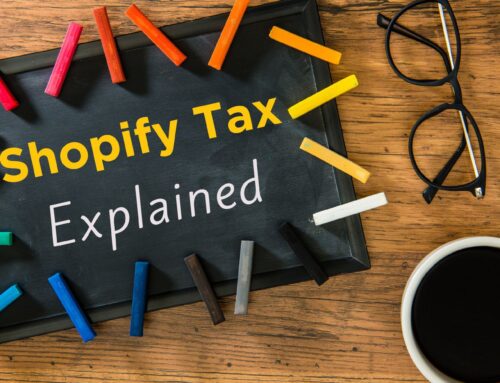
Are you a new Shopify seller? Does the thought of keeping up with sales taxes just make you want to run away and hide? No worries. Today, I’m breaking down the biggest sales tax mistakes that new Shopify sellers make with US sales taxes, and I’ll even explain sales taxes to you at the end.
Mistake #1: Panic
Sales tax rules can be complicated, but there’s no need to panic. In fact, most new sellers don’t have to worry about collecting sales taxes in other states until they meet the minimum threshold.
You do need to understand the basics of sales taxes, and I’ll give you an overview of sales taxes at the end of this article. Unfortunately, the process of learning about sales tax leads to mistake number two.
Mistake #2: Bad advice
As a new Shopify seller, you might find yourself in a common situation: you panic and look for advice from the first place you can find it. Many times, this means you seek advice from online groups who are filled with people who are scared about sales taxes just like you. Or you consult your local accountant who’s not familiar with sales taxes for online sellers. Maybe you simply log into Shopify, and it tells you that you have met the threshold in the state.
Keep in mind that people in online groups, and even the folks at Shopify, are not sales tax experts. Many of them will say, “I heard that” or “I read this somewhere.” But you don’t want to make business decisions based on what someone may have heard.
Another thing to keep in mind is that most accountants are not trained in sales taxes. Sales tax compliance for online sellers is a specialty, and few accountants work on or even know about it. Sadly, in most cases, you’ll end up making these first two mistakes. And that leads us to mistake number three…
Mistake #3: Registering in every state
So you asked around and someone told you that you need to register to collect sales taxes in every state. Wrong!
You don’t have to register to collect sales taxes unless you have met something called “nexus,” and in a few paragraphs, I’ll explain to you exactly what nexus is.
Mistake #4: Collecting sales tax without registering
You might also make a mistake on the opposite end of the spectrum. Some Shopify sellers end up collecting sales taxes without registration, and that’s wrong, too. You should not collect sales taxes unless you register in a state.
Mistake #5: Not understanding sales tax basics for online sellers
Let’s unravel the mysteries of sales taxes so that you can avoid making these costly sales tax mistakes.
One of the most important things you should know about sales taxes is that the rules are different for every state, and the rules change on a regular basis. For Shopify sellers, the burden is on the seller to register, collect and remit sales taxes.
Sales tax nexus
When it comes to sales taxes, you need to consider whether you have physical nexus and/or economic nexus.
But what is nexus? Nexus is the level of connection that you have with a state or jurisdiction. That’s just a fancy way of saying that once you have nexus in the state, then you need to register, collect, and remit sales taxes in that state.
- Physical nexus
The first type of nexus that you need to consider is physical nexus. For many states, physical nexus has to do with whether you have a physical presence in the state. This refers to situations like whether you have warehouses in a particular state, or even whether you have employees or sales reps.
Keep in mind that every state has different rules, so you need to make sure that you look up your state and see whether you have physical nexus, as well as other states based on these physical nexus rules.
- Economic nexus
The second type of nexus is economic nexus. Economic nexus refers to when you sell from one state to other states. You must meet the minimum threshold for each state before you have economic nexus, and the minimum thresholds are based on minimum dollar amounts or number of transactions.
You also have to consider product taxability. Is the product that you’re selling taxable in a state? For example, I have a client who sells clothing, and clothing is not taxable in every state.
Sales tax experts recommend that you do a nexus study. To do so, you look at all of the states in which you have had sales for a particular period of time, and you look back to see whether you’ve met the minimum threshold for a dollar amount of transactions or number of transactions. Then, you also have to assess product taxability in the states in which you have nexus.
Once you’ve determined that you have nexus and that your product is taxable in a state, then you need to register and begin to collect and remit sales taxes. It’s important that you do it in that order. You need to register for sales taxes before you can collect sales taxes, and then once you collect, you can remit.
If you’re looking for a resource to help you determine if you have economic nexus, my friends at salestaxandmore.com have put together a free chart. They specialize in sales taxes, and they’ve created the Economic Nexus Thresholds for sales tax chart to help you.
[Video 5:50] You can follow along with me in the video as we take a look at examples for Arkansas, Arizona, and California.
The financial threshold in Arkansas is $100,000 in sales, and their transaction threshold is 200 transactions. The look back period in this state is the previous or current calendar year.
In Arizona, the financial threshold is $100,000 in sales, and they don’t have a minimum transaction threshold.
Finally, for California, their monetary threshold is $500,000.
As a new Shopify seller, all of this information should make you breathe a sigh of relief. Unless you have met the monetary thresholds or transaction thresholds for these states, you don’t have to worry on day one (from an economic nexus standpoint). This is because you must first meet the monetary or transaction thresholds in all of these states. If you have sales into the state of California, for example, you have to wait until you have $500,000 in sales for the previous or current calendar year before you would reach economic nexus.
Closing
I hope that this article has shed some light on sales tax for Shopify sellers, and I hope it will help you avoid some common sales tax mistakes.
If you feel ready to work with an experienced and reliable Shopify accounting pro, click here to learn more about my services and see how we might be able to work together.
In the meantime, enjoy free access to plenty more resources, like my YouTube channel and my free Shopify Bookkeeping Blueprint. If you’d also like to connect with fellow DIY Shopify sellers and professional bookkeepers, come join my Facebook community. You can also follow me on Instagram to get all kinds of tips for DIY Shopify bookkeepers.
I’m here to help you, so I hope to see you soon online.




